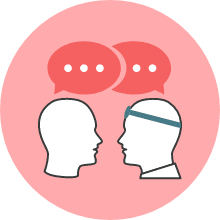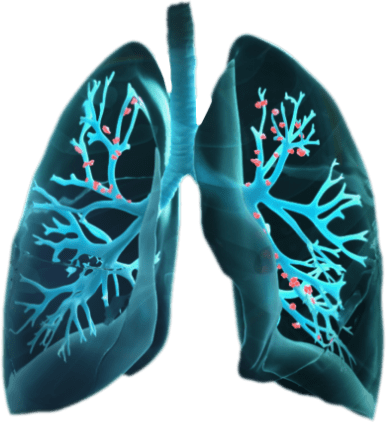WHEN SHOULD YOU TREAT NTM?

Having NTM lung disease for a long period of time can cause damage to the lungs that can worsen over time. This is why, once you are diagnosed, it’s important to talk to your doctor about your plan for getting rid of the infection. This type of infection does not go away on its own and, if left untreated, can have a serious, long-term impact on your health.
There are treatment options available for NTM lung disease. You and your doctor should work together to determine if you need treatment. You may be prescribed a treatment regimen or you may be referred to a specialist who has more experience treating people with NTM lung disease.
It’s important to educate yourself and ask your doctor questions about what to expect after diagnosis.
NTM lung disease causes damage to your lungs that will only get worse with time.
Explore the damaging effects
GUIDELINE-RECOMMENDED Treatment
The NTM Treatment Guidelines* were created by leading scientific communities to provide doctors with recommendations for the treatment of NTM lung disease. These guidelines are the globally recognized standard for the management of NTM lung disease.
Review the guidelines and speak to your doctor to find out if these guidelines could impact your treatment plan.
MAC lung disease is diagnosed
Begin treatment after NTM diagnosis
Guidelines recommend a multidrug regimen of at least 3 antibiotics
Guidelines suggest starting treatment rather than waiting for certain diagnosed patients, especially those who have:
- a more severe infection
- a compromised immune system
- symptoms such as severe fatigue or other signs of decreased quality of life
- cavitary disease
Months 1 to 5 after starting treatment
Regular sputum testing is recommended
Get sputum tested every 1 to 2 months while on treatment
Guidelines recommend regular doctor visits and monthly sputum cultures in order to assess whether or not a patient is responding to therapy.
6 months after starting treatment
Assess treatment success at 6 months
Have you tested negative for MAC bacteria?
Guidelines recommend that doctors evaluate if the multidrug regimen is working after 6 months of treatment.
Additional guidelines recommendation
The guidelines recommend staying on treatment for a minimum of 12 months after testing negative for MAC. This is to make sure the MAC bacteria are cleared from your lungs.
*Guidelines developed by ATS/ERS/ESCMID/IDSA.
ATS=American Thoracic Society; ERS=European Respiratory Society; ESCMID=European Society of Clinical Microbiology and Infectious Diseases; IDSA=Infectious Diseases Society of America.
Lifestyle Changes
When you’re living with a lung condition, it’s especially important to maintain a healthy lifestyle and limit your exposure to NTM bacteria. That’s because exercise and diet can affect how your body works. Remember, you can always talk to your doctor if you have any questions about your lung health.
Reducing exposure
While NTM is in the environment, you and your loved ones can follow these steps to reduce exposure to NTM bacteria:
- Raise hot water heater temperatures to at least 130°F
- Use well water, rather than piped-utility supply, if possible
- Avoid long exposure to shower aerosols (shorter showers)
- Disinfect showerhead by submerging in household bleach or vinegar for 30 minutes
- Use showerhead with large holes to reduce mist formation
- Drain hot water heater frequently to remove sediment
- If you have a water filter, follow manufacturers’ instructions for changing it
- Avoid continual use of humidifiers without cleaning them
- Have good bathroom exhaust
- For drinking and cooking, boiling (ie, 212°F) for 10 minutes kills NTM
- Wear a mask, when appropriate, to avoid dust inhalation
- Moisten garden and potting soils
Read more about reducing exposure to NTM:
Tips for healthy living
Managing airway clearance
- Managing airway clearance
- NTM lung disease can make your body create excess mucus in your airways. Using certain airway clearance techniques in addition to taking your medicine can help you clear the mucus from your lungs.
- Talk to your doctor about ways to manage mucus clearance.
Exercise
- Exercise
- Light activity, such as walking, has many health benefits:
- Makes daily activities easier
- Provides long-term health benefits
- Talk to your doctor to see if starting an exercise routine is right for you.
Quit smoking
- Quit smoking
- Smoking is also a leading cause of lung problems and lung cancer. Quitting may not be easy, but it can improve your health. Your doctor can help you develop a plan to stop smoking.
Maintain a well-balanced diet
- Maintain a well-balanced diet
- Your diet has an effect on how your body works. Having a well-balanced diet can help by minimizing inflammation.
Whether you’re traveling far away or just seeing family or friends nearby, here are a few tips to help you manage your lung condition, even when you’re on the go.
Download Health and Wellness Guide
Connect with others living with NTM lung disease
There are communities available to support you on your journey with NTM lung disease. Find out how to join an online discussion or an in-person support group, and where to find resources to help start your own.
To talk to other people who have NTM lung disease, visit
Nutrition tips
One of the symptoms of NTM lung disease is weight loss.
It’s important to maintain a healthy weight and eat a well-balanced diet. Eating right may help you feel better. Remember, always talk to your doctor before making any changes to your diet.
Stick to foods that can help minimize inflammation.
Some foods may help more than others
because of their high levels of key vitamins and minerals.
- Fruits
- Papaya
- Cantaloupe
- Citrus fruits, like oranges or grapefruit
- Strawberries
- Apples
- Sweet peppers
- Lemons
- Vegetables
- Cauliflower
- Broccoli
- Brussels sprouts
- Kale
- Carrots
- Sweet potatoes
- Other Foods
- Eggs
- Milk
- Nuts
- Cereal grains
- Seafood, including fish and shellfish
- Vitamins
- Vitamin C
- Vitamin E
- Vitamin A
- Fatty acids
- Magnesium
- Selenium
Be sure to talk to your doctor or see a dietitian before starting any new vitamins.
Keep up your appetite
- Eat 5 to 6 small meals a day and snack whenever you are hungry
- When you’re hungry, have a high-protein snack like nuts
- Calorie-boost a meal with sauces, cheese, or butter
- Eat heartier foods first at mealtimes to avoid filling up on lower-calorie foods
- Don’t fill up on fluids
- Want a drink? Try milkshakes and protein drinks
- Make it spicy if your sense of taste has faded
- Take a walk. A 20-minute walk an hour before eating helps keep up your hunger
- Keep a food journal. Knowing what you’re eating is key
This nutrition guide is only a suggestion. You can talk to your doctor or a dietitian if you'd like help putting together a meal plan, or if you have any questions or concerns.
If you find out you have NTM lung disease, you're not alone. People like you have shared their stories in hopes of spreading more awareness about this disease.
Watch patients discuss their journey

